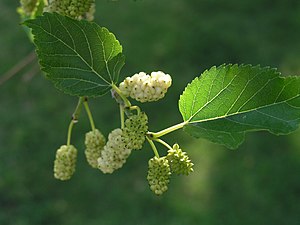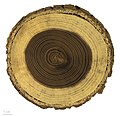Morus Alba
Morus alba, known as white mulberry, common mulberry and silkworm mulberry, is a fast-growing, small to medium-sized mulberry tree which grows to 10–20 m (33–66 ft) tall. It is generally a short-lived tree with a lifespan comparable to that of humans, although there are some specimens known to be more than 250 years old. The species is native to China and India and is widely cultivated and naturalized elsewhere (including United States, Mexico, Australia, Kyrgyzstan, Argentina, Turkey, Iran, and many others).
| White mulberry | |
|---|---|
 | |
| Scientific classification | |
| Kingdom: | Plantae |
| Clade: | Tracheophytes |
| Clade: | Angiosperms |
| Clade: | Eudicots |
| Clade: | Rosids |
| Order: | Rosales |
| Family: | Moraceae |
| Genus: | Morus |
| Species: | M. alba |
| Binomial name | |
| Morus alba L. 1753 | |
| Subspecies | |
| |
| Synonyms | |
| |
The white mulberry is widely cultivated to feed the silkworms employed in the commercial production of silk. It is also notable for the rapid release of its pollen, which is launched at greater than half the speed of sound. Its berries are edible when ripe.
Description


On young, vigorous shoots, the leaves may be up to 30 cm (12 in) long, and deeply and intricately lobed, with the lobes rounded. On older trees, the leaves are generally 5–15 cm (2.0–5.9 in) long, unlobed, cordate at the base and rounded to acuminate at the tip, and serrated on the margins. Generally, the trees are deciduous in temperate regions, but trees grown in tropical regions may be evergreen.
The flowers are single-sex catkins; male catkins are 2–3.5 cm (0.8–1.4 in) long, and female catkins 1–2 cm (0.4–0.8 in) long. Male and female flowers are usually found on separate trees although they may occur on the same tree. The fruit is 1–1.5 cm (0.4–0.6 in) long. In the wild it is deep purple, but in many cultivated plants it varies from white to pink. It is sweet but bland, unlike the more intense flavor of the red mulberry and black mulberry. The seeds are widely dispersed in the droppings of birds that eat the fruit.
The white mulberry is scientifically notable for the rapid plant movement involved in pollen release from its catkins. The stamens act as catapults, releasing stored elastic energy in just 25 μs. The resulting movement is approximately 380 miles per hour (610 km/h), about half the speed of sound, making it the fastest known movement in the plant kingdom.
Taxonomy
Two varieties of Morus alba are recognized:
- Morus alba var. alba
- Morus alba var. multicaulis
Cultivation

Cultivation of white mulberry to nourish silkworms began more than 4,700 years ago in China and has since been introduced in other countries. The Ancient Greeks and Romans cultivated the mulberry for silkworms. At least as early as 220 AD, Emperor Elagabalus wore a silk robe. It was introduced into other parts of Europe in the twelfth century and into Latin America after the Spanish conquest in the fifteenth century. In 2002, 6,260 km2 of land were devoted to the species in China.
It has been grown widely from the Indian subcontinent west through Afghanistan and Iran to southern Europe for more than a thousand years for leaves to feed silkworms.
More recently, it has become widely naturalized in disturbed areas such as roadsides and the edges of tree lots, along with urban areas in much of North America, where it hybridizes readily with the locally native red mulberry (Morus rubra). There is now serious concern for the long-term genetic viability of the red mulberry because of extensive hybridization in some areas.
The species is now extensively planted and widely naturalized throughout the warm temperate world and in subarctic regions as well, and would survive in elevations as high as 4,000 metres (13,000 ft). They thrive in mildly acidic, well drained, sandy loam and clayey loam soils, though they can withstand poor soils as well.
Toxicity
Tests on laboratory rats have not found mulberry extract to present significant toxicity.
According to a coroner's report, Lori McClintock, wife of US politician Tom McClintock, died in December 2021 from dehydration due to gastroenteritis caused by "adverse effects of white mulberry leaf ingestion"; the leaf is used as a dietary supplement or herbal remedy for weight loss and diabetes.
Uses

White mulberry leaves are the preferred feedstock for silkworms, and are also cut for food for livestock (cattle, goats, etc.) in areas where dry seasons restrict the availability of ground vegetation.
The leaves are prepared as tea in Korea. The fruit are also eaten, often dried or made into wine.
For landscaping, a fruitless mulberry was developed from a clone for use in the production of silk in the U.S. The industry never materialized, but the mulberry variety is now used as an ornamental tree where shade is desired without the fruit.
White mulberry, Morus alba 'Pendula', is used as an ornamental plant. It was planted at several grand stations built along the Lackawanna Railroad in New Jersey during the late 1800s and early 1900s. The species is a lawn tree across the desert cities of the southwestern United States, prized for its shade and also for its cylindrical berry clusters composed of sweet, purplish-white fruits. The plant's pollen is problematic in some cities where it has been blamed for an increase in hay fever.
See also
- Blackberry, which looks similar
- Sericulture, silk farming
- Osage orange
Gallery
- Morus alba - MHNT
- Fruitless mulberry trees
- Pennsylvania state champion Morus alba at Longwood Gardens.
- Leaves and male flowers in the spring.
- Leaf variation
- Morus alba flowers in India
- Flowers and leaves in Spain
- Fruits in India
- 'Pendula' cultivar in Iran
- A tree planted by Edmond James de Rothschild in 1922 in attempt to build silk industry in Israel
- Mulberries fallen to the ground in peak season.
References
External links
 Data related to Morus alba at Wikispecies
Data related to Morus alba at Wikispecies
- USDA Plants Profile for Morus alba white mulberry
- "Morus alba". Germplasm Resources Information Network. Agricultural Research Service, United States Department of Agriculture.
- Morton Arboretum: Diagnostic photos of white mulberry tree (acc. 380*82-1)
- Invasive.org: U.S. National Forest Service, Invasive Species Weed of the Week − Morus alba

This article uses material from the Wikipedia English article Morus alba, which is released under the Creative Commons Attribution-ShareAlike 3.0 license ("CC BY-SA 3.0"); additional terms may apply (view authors). Content is available under CC BY-SA 4.0 unless otherwise noted. Images, videos and audio are available under their respective licenses.
®Wikipedia is a registered trademark of the Wiki Foundation, Inc. Wiki English (DUHOCTRUNGQUOC.VN) is an independent company and has no affiliation with Wiki Foundation.










